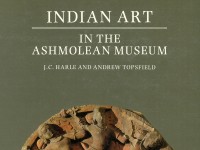Indian Art in the Ashmolean Museum
A catalogue of the Ashmolean’s collection of Indian art by J. C. Harle and Andrew Topsfield (published Oxford, 1987).

Publications online: 143 objects
- Reference URL
Actions
Teaching bodhisattva
-
Literature notes
Bodhisattvas, which play a part in Buddhist art second only to that of the Buddha himself are future Buddhas who have chosen to remain on earth for the time being to help other creatures towards eventual Enlightenment. The Museum’s example, a stele in very high relief, probably adorned the exterior of a stūpa [see EA1978.127] or other religious edifice in a Buddhist monastery. As was the custom in Gandhara, the Bodhisattva is depicted dressed and bejewelled like a magnate of the region and the pose an iconography belong to the Indian tradition. The pose of the hands (mundrā) in this case signifies preaching (dharmacakramundrā) namely the Buddhist dharma or Law. As in the previous image, however, the style bears the clear marks of Graeco-Roman influence. The two narrow bands extending out form the turban almost certainly echo the ends of the knotted Greek diadem.
The figure sits on a low throne in the Indian pose known as padmāsana, both the feet placed, sole upward, on the thigh of the other leg. Below the cushion against a background of drapery, two small figures in relief, with their hands in añjali, the gesture of respect of worship, flank what appears to be a begging bowl. That it is a sacred object is indicated by the throne on which it too is placed and it may stand for the Buddha [see EAOS.26]. The two worshippers, male and female, almost certainly represent the donors. -
Description
Formerly adorning a stupa or other monastic building, the Bodhisattva (future Buddha) makes the gesture of teaching or turning the Wheel of the Dharma. Two donor figures perform a fire ritual below.
-
Details
- Associated place
-
Asia › Pakistan › North-West Frontier Province › Mardan district › Hoti (an ancient Buddhist monastery) (possible original location)
- Date
- AD 150 - 250
- Material and technique
- schist
- Dimensions
- 58 x 30 x 13 cm approx. (height x width x depth)
- Material index
- Technique index
- Object type index
- No. of items
- 1
- Credit line
- Presented by Mrs Gooding.
- Accession no.
- EAOS.24
-
Further reading
Harle, J. C., and Andrew Topsfield, Indian Art in the Ashmolean Museum (Oxford: Ashmolean Museum, 1987), no. 16 on p. 14, pp. 13 & 17, illus. p. 14
Veradi, Giovanni, Homa and other fire rituals in Gandhara, Supplemento… agli Annali, 79. (Naples: Instituto Universitario Orientale, 1994), 16-17, figs.27-28
Piper, David, and Christopher White, Treasures of the Ashmolean Museum: An Illustrated Souvenir of the Collections, revised edn (Oxford: Ashmolean Museum, 1995), no. 36 on p. 41, illus. p. 40 fig. 36
Location
Objects are sometimes moved to a different location. Our object location data is usually updated on a monthly basis. Contact the Jameel Study Centre if you are planning to visit the museum to see a particular object on display, or would like to arrange an appointment to see an object in our reserve collections.
Publications online
-

Indian Art in the Ashmolean Museum
Bodhisattvas, which play a part in Buddhist art second only to that of the Buddha himself are future Buddhas who have chosen to remain on earth for the time being to help other creatures towards eventual Enlightenment. The Museum’s example, a stele in very high relief, probably adorned the exterior of a stūpa [see EA1978.127] or other religious edifice in a Buddhist monastery. As was the custom in Gandhara, the Bodhisattva is depicted dressed and bejewelled like a magnate of the region and the pose an iconography belong to the Indian tradition. The pose of the hands (mundrā) in this case signifies preaching (dharmacakramundrā) namely the Buddhist dharma or Law. As in the previous image, however, the style bears the clear marks of Graeco-Roman influence. The two narrow bands extending out form the turban almost certainly echo the ends of the knotted Greek diadem.
The figure sits on a low throne in the Indian pose known as padmāsana, both the feet placed, sole upward, on the thigh of the other leg. Below the cushion against a background of drapery, two small figures in relief, with their hands in añjali, the gesture of respect of worship, flank what appears to be a begging bowl. That it is a sacred object is indicated by the throne on which it too is placed and it may stand for the Buddha [see EAOS.26]. The two worshippers, male and female, almost certainly represent the donors.
Galleries
Notice
Object information may not accurately reflect the actual contents of the original publication, since our online objects contain current information held in our collections database. Click on 'buy this publication' to purchase printed versions of our online publications, where available, or contact the Jameel Study Centre to arrange access to books on our collections that are now out of print.
© 2013 University of Oxford - Ashmolean Museum



